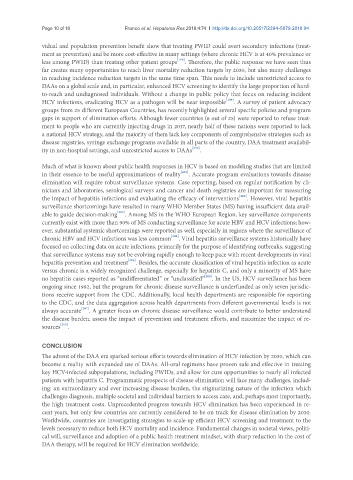Page 836 - Read Online
P. 836
Page 10 of 18 Franco et al. Hepatoma Res 2018;4:74 I http://dx.doi.org/10.20517/2394-5079.2018.94
vidual and population prevention benefit show that treating PWID could avert secondary infections (treat-
ment as prevention) and be more cost-effective in many settings (where chronic HCV is at 40% prevalence or
less among PWID) than treating other patient groups [198] . Therefore, the public response we have seen thus
far creates many opportunities to reach liver mortality reduction targets by 2030, but also many challenges
in reaching incidence reduction targets in the same time span. This needs to include unrestricted access to
DAAs on a global scale and, in particular, enhanced HCV screening to identify the large proportion of hard-
to-reach and undiagnosed individuals. Without a change in public policy that focus on reducing incident
HCV infections, eradicating HCV as a pathogen will be near impossible [199] . A survey of patient advocacy
groups from 25 different European Countries, has recently highlighted several specific policies and program
gaps in support of elimination efforts. Although fewer countries (8 out of 25) were reported to refuse treat-
ment to people who are currently injecting drugs in 2017, nearly half of these nations were reported to lack
a national HCV strategy, and the majority of them lack key components of comprehensive strategies such as
disease registries, syringe exchange programs available in all parts of the country, DAA treatment availabil-
ity in non-hospital settings, and unrestricted access to DAAs [200] .
Much of what is known about public health responses in HCV is based on modeling studies that are limited
in their essence to be useful approximations of reality [201] . Accurate program evaluations towards disease
elimination will require robust surveillance systems. Case reporting, based on regular notification by cli-
nicians and laboratories, serological surveys and cancer and death registries are important for measuring
the impact of hepatitis infections and evaluating the efficacy of interventions [202] . However, viral hepatitis
surveillance shortcomings have resulted in many WHO Member States (MS) having insufficient data avail-
able to guide decision-making [203] . Among MS in the WHO European Region, key surveillance components
currently exist with more than 90% of MS conducting surveillance for acute HBV and HCV infections; how-
ever, substantial systemic shortcomings were reported as well, especially in regions where the surveillance of
chronic HBV and HCV infections was less common [204] . Viral hepatitis surveillance systems historically have
focused on collecting data on acute infections, primarily for the purpose of identifying outbreaks, suggesting
that surveillance systems may not be evolving rapidly enough to keep pace with recent developments in viral
hepatitis prevention and treatment [205] . Besides, the accurate classification of viral hepatitis infection as acute
versus chronic is a widely recognized challenge, especially for hepatitis C, and only a minority of MS have
[206]
no hepatitis cases reported as “undifferentiated” or “unclassified” . In the US, HCV surveillance has been
ongoing since 1982, but the program for chronic disease surveillance is underfunded as only seven jurisdic-
tions receive support from the CDC. Additionally, local health departments are responsible for reporting
to the CDC, and the data aggregation across health departments from different governmental levels is not
always accurate [207] . A greater focus on chronic disease surveillance would contribute to better understand
the disease burden, assess the impact of prevention and treatment efforts, and maximize the impact of re-
sources [208] .
CONCLUSION
The advent of the DAA era sparked serious efforts towards elimination of HCV infection by 2030, which can
become a reality with expanded use of DAAs. All-oral regimens have proven safe and effective in treating
key HCV-infected subpopulations, including PWIDs, and allow for cure opportunities to nearly all infected
patients with hepatitis C. Programmatic prospects of disease elimination will face many challenges, includ-
ing: an extraordinary and ever increasing disease burden, the stigmatizing nature of the infection which
challenges diagnosis, multiple societal and individual barriers to access care, and, perhaps most importantly,
the high treatment costs. Unprecedented progress towards HCV elimination has been experienced in re-
cent years, but only few countries are currently considered to be on track for disease elimination by 2030.
Worldwide, countries are investigating strategies to scale-up efficient HCV screening and treatment to the
levels necessary to reduce both HCV mortality and incidence. Fundamental changes in societal views, politi-
cal will, surveillance and adoption of a public health treatment mindset, with sharp reduction in the cost of
DAA therapy, will be required for HCV elimination worldwide.

